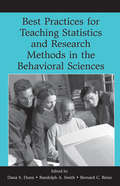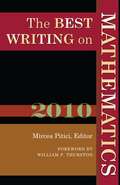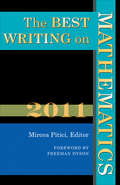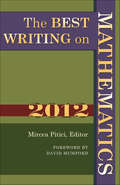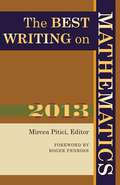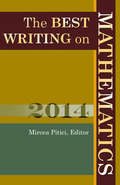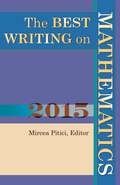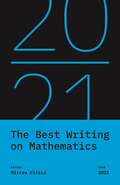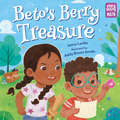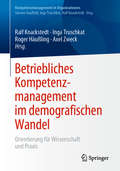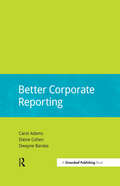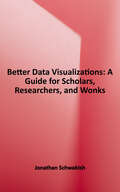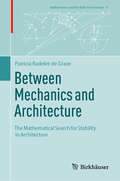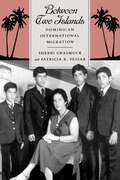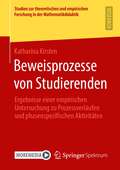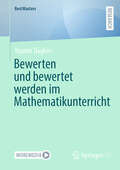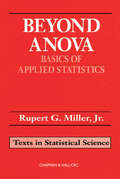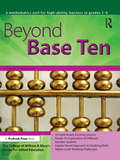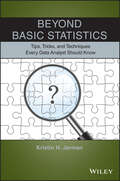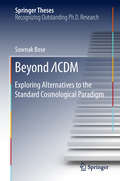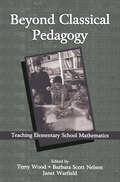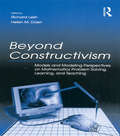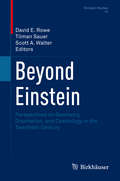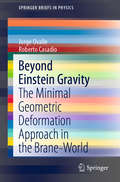- Table View
- List View
Best Practices in Teaching Statistics and Research Methods in the Behavioral Sciences
by Dana S. Dunn Randolph A. Smith Bernard C. BeinsThis book provides a showcase for "best practices" in teaching statistics and research methods in two- and four-year colleges and universities.A helpful resource for teaching introductory, intermediate, and advanced statistics and/or methods, the book features coverage of:ways to integrate these courseshow to promote ethical conducthow to create wr
The Best Writing on Mathematics 2010 (The Best Writing on Mathematics #1)
by Mircea PiticiThis anthology brings together the year's finest writing on mathematics from around the world. Featuring promising new voices alongside some of the foremost names in mathematics, The Best Writing on Mathematics makes available to a wide audience many articles not easily found anywhere else--and you don't need to be a mathematician to enjoy them. These writings offer surprising insights into the nature, meaning, and practice of mathematics today. They delve into the history, philosophy, teaching, and everyday occurrences of math, and take readers behind the scenes of today's hottest mathematical debates. Here readers will discover why Freeman Dyson thinks some mathematicians are birds while others are frogs; why Keith Devlin believes there's more to mathematics than proof; what Nick Paumgarten has to say about the timing patterns of New York City's traffic lights (and why jaywalking is the most mathematically efficient way to cross Sixty-sixth Street); what Samuel Arbesman can tell us about the epidemiology of the undead in zombie flicks; and much, much more. In addition to presenting the year's most memorable writing on mathematics, this must-have anthology also includes a foreword by esteemed mathematician William Thurston and an informative introduction by Mircea Pitici. This book belongs on the shelf of anyone interested in where math has taken us--and where it's headed.
The Best Writing on Mathematics 2011
by Freeman Dyson Mircea PiticiThis anthology brings together the year's finest mathematics writing from around the world. Featuring promising new voices alongside some of the foremost names in the field, The Best Writing on Mathematics 2011 makes available to a wide audience many articles not easily found anywhere else--and you don't need to be a mathematician to enjoy them. These writings offer surprising insights into the nature, meaning, and practice of mathematics today. They delve into the history, philosophy, teaching, and everyday occurrences of math, and take readers behind the scenes of today's hottest mathematical debates. Here Ian Hacking discusses the salient features that distinguish mathematics from other disciplines of the mind; Doris Schattschneider identifies some of the mathematical inspirations of M. C. Escher's art; Jordan Ellenberg describes compressed sensing, a mathematical field that is reshaping the way people use large sets of data; Erica Klarreich reports on the use of algorithms in the job market for doctors; and much, much more. In addition to presenting the year's most memorable writings on mathematics, this must-have anthology includes a foreword by esteemed physicist and mathematician Freeman Dyson. This book belongs on the shelf of anyone interested in where math has taken us--and where it is headed.
The Best Writing on Mathematics 2012 (The Best Writing on Mathematics #3)
by Mircea PiticiThe year's finest writing on mathematics from around the worldThis annual anthology brings together the year's finest mathematics writing from around the world. Featuring promising new voices alongside some of the foremost names in the field, The Best Writing on Mathematics 2012 makes available to a wide audience many articles not easily found anywhere else--and you don't need to be a mathematician to enjoy them. These writings offer surprising insights into the nature, meaning, and practice of mathematics today. They delve into the history, philosophy, teaching, and everyday occurrences of math, and take readers behind the scenes of today's hottest mathematical debates. Here Robert Lang explains mathematical aspects of origami foldings; Terence Tao discusses the frequency and distribution of the prime numbers; Timothy Gowers and Mario Livio ponder whether mathematics is invented or discovered; Brian Hayes describes what is special about a ball in five dimensions; Mark Colyvan glosses on the mathematics of dating; and much, much more.In addition to presenting the year's most memorable writings on mathematics, this must-have anthology includes a foreword by esteemed mathematician David Mumford and an introduction by the editor Mircea Pitici. This book belongs on the shelf of anyone interested in where math has taken us--and where it is headed.
The Best Writing on Mathematics 2013 (The Best Writing on Mathematics #4)
by Mircea PiticiThe year's finest writing on mathematics from around the world, with a foreword by Nobel Prize–winning physicist Roger PenroseThis annual anthology brings together the year's finest mathematics writing from around the world. Featuring promising new voices alongside some of the foremost names in the field, The Best Writing on Mathematics 2013 makes available to a wide audience many articles not easily found anywhere else—and you don't need to be a mathematician to enjoy them. These writings offer surprising insights into the nature, meaning, and practice of mathematics today. They delve into the history, philosophy, teaching, and everyday occurrences of math, and take readers behind the scenes of today's hottest mathematical debates. Here Philip Davis offers a panoramic view of mathematics in contemporary society; Terence Tao discusses aspects of universal mathematical laws in complex systems; Ian Stewart explains how in mathematics everything arises out of nothing; Erin Maloney and Sian Beilock consider the mathematical anxiety experienced by many students and suggest effective remedies; Elie Ayache argues that exchange prices reached in open market transactions transcend the common notion of probability; and much, much more.In addition to presenting the year's most memorable writings on mathematics, this must-have anthology includes a foreword by esteemed mathematical physicist Roger Penrose and an introduction by the editor, Mircea Pitici. This book belongs on the shelf of anyone interested in where math has taken us—and where it is headed.
The Best Writing on Mathematics 2014
by Mircea PiticiThis annual anthology brings together the year's finest mathematics writing from around the world. Featuring promising new voices alongside some of the foremost names in the field, The Best Writing on Mathematics 2014 makes available to a wide audience many articles not easily found anywhere else—and you don’t need to be a mathematician to enjoy them. These writings offer surprising insights into the nature, meaning, and practice of mathematics today. They delve into the history, philosophy, teaching, and everyday occurrences of math, and take readers behind the scenes of today’s hottest mathematical debates. Here John Conway presents examples of arithmetical statements that are almost certainly true but likely unprovable; Carlo Séquin explores, compares, and illustrates distinct types of one-sided surfaces known as Klein bottles; Keith Devlin asks what makes a video game good for learning mathematics and shows why many games fall short of that goal; Jordan Ellenberg reports on a recent breakthrough in the study of prime numbers; Stephen Pollard argues that mathematical practice, thinking, and experience transcend the utilitarian value of mathematics; and much, much more.In addition to presenting the year’s most memorable writings on mathematics, this must-have anthology includes an introduction by editor Mircea Pitici. This book belongs on the shelf of anyone interested in where math has taken us—and where it is headed.
The Best Writing on Mathematics 2015 (The Best Writing on Mathematics #14)
by Mircea PiticiThe year's finest writing on mathematics from around the worldThis annual anthology brings together the year's finest mathematics writing from around the world. Featuring promising new voices alongside some of the foremost names in the field, The Best Writing on Mathematics 2015 makes available to a wide audience many articles not easily found anywhere else—and you don’t need to be a mathematician to enjoy them. These writings offer surprising insights into the nature, meaning, and practice of mathematics today. They delve into the history, philosophy, teaching, and everyday occurrences of math, and take readers behind the scenes of today’s hottest mathematical debates.Here David Hand explains why we should actually expect unlikely coincidences to happen; Arthur Benjamin and Ethan Brown unveil techniques for improvising custom-made magic number squares; Dana Mackenzie describes how mathematicians are making essential contributions to the development of synthetic biology; Steven Strogatz tells us why it’s worth writing about math for people who are alienated from it; Lisa Rougetet traces the earliest written descriptions of Nim, a popular game of mathematical strategy; Scott Aaronson looks at the unexpected implications of testing numbers for randomness; and much, much more.In addition to presenting the year’s most memorable writings on mathematics, this must-have anthology includes a bibliography of other notable writings and an introduction by the editor, Mircea Pitici. This book belongs on the shelf of anyone interested in where math has taken us—and where it is headed.
The Best Writing on Mathematics 2021 (The Best Writing on Mathematics #20)
by Mircea PiticiThe year’s finest mathematical writing from around the worldThis annual anthology brings together the year’s finest mathematics writing from around the world—and you don’t need to be a mathematician to enjoy the pieces collected here. These essays—from leading names and fresh new voices—delve into the history, philosophy, teaching, and everyday aspects of math, offering surprising insights into its nature, meaning, and practice, and taking readers behind the scenes of today’s hottest mathematical debates.Here, Viktor Blåsjö gives a brief history of “lockdown mathematics”; Yelda Nasifoglu decodes the politics of a seventeenth-century play in which the characters are geometric shapes; and Andrew Lewis-Pye explains the basic algorithmic rules and computational procedures behind cryptocurrencies. In other essays, Terence Tao candidly recalls the adventures and misadventures of growing up to become a leading mathematician; Natalie Wolchover shows how old math gives new clues about whether time really flows; and David Hand discusses the problem of “dark data”—information that is missing or ignored. And there is much, much more.
Beto's Berry Treasure (Storytelling Math)
by Jenny LacikaCelebrate diversity, math, and the power of storytelling!Beto wants to play tea party with Cora, but his big sister just wants to be a pirate. To get Cora on board, Beto makes a map to a delicious hidden treasure. But Cora ends up in the wrong place! Will Cora find the treasure before Beto eats it all? A playful exploration of mapping, featuring Chicanx (Mexican American) characters and a glossary of Spanish words.Storytelling Math celebrates children using math in their daily adventures as they play, build, and discover the world around them. Joyful stories and hands-on activities make it easy for kids and their grown-ups to explore everyday math together. Developed in collaboration with math experts at STEM education nonprofit TERC, under a grant from the Heising-Simons Foundation.
Betriebliches Kompetenzmanagement im demografischen Wandel: Orientierung für Wissenschaft und Praxis (Kompetenzmanagement in Organisationen)
by Ralf Knackstedt Inga Truschkat Roger Häußling Axel ZweckDie in diesem Fachbuch präsentierten Orientierungshilfen ermöglichen einen Überblick über die große Vielfalt der in Wissenschaft und Praxis in den letzten Jahren entwickelten Problemlösungen für das betriebliche Kompetenzmanagement. Als Leserin oder Leser lernen Sie Werkzeuge kennen, um für das Kompetenzmanagement relevante Lösungsansätze zu identifizieren, wichtige Trends zu erkennen und den in der eigenen Organisation erreichten Entwicklungsstand kritisch zu reflektieren. Die präsentierten Ansätze zeigen Synergiepotenziale zwischen wissenschaftlichen Erkenntnissen und praktischen Methoden auf und helfen Ihnen daher sowohl in der wissenschaftlichen Forschung wie auch in der Praxis.
Better Corporate Reporting (Doshorts Ser.)
by Carol Adams Elaine Cohen Dwayne BarakaBetter Corporate Reporting outlines the latest frameworks for enhancing non-financial and sustainability reporting. It shows you how to integrate non-financial data into your reporting and overall strategy, creating long-term value, trust and transparency. It includes guides to: the International Integrated Reporting Council's new framework; the Global Reporting Initiative's G4 framework; and a detailed look at the concept at the heart of both of these new frameworks, materiality. It is the compilation of 3 bestselling sustainability guides on sustainability reporting.Understanding Integrated Reporting provides a practical and expert distillation of the new IR framework released by the International Integrated Reporting Council in December 2013. It explains what IR is and how to do it; how it links with other reporting frameworks and what it means in terms of thinking and processes. You'll also get a clear business case for IR and insights and best practice examples from leading integrated reporters. The Global Reporting Initiative (GRI) G4 Sustainability Reporting Framework was launched in May 2013. In Understanding G4, corporate reporting veteran Elaine Cohen presents an easy-to-follow review of everything any organization needs to know to decide whether to use the G4 Framework and if so, how. Materiality is the lynch-pin that can align your sustainability initiatives with your overall strategy. Making Sustainability Matter shows you how to identify your organization's most material sustainability issues, allocate resources to sustainability initiatives for optimal returns; connect your communications and reporting to materiality, and; clarify which issues are important to your stakeholders. Materiality is a core concept in both the GRI's new G4 framework the IIRC's new Integrated Reporting framework.
Better Data Visualizations: A Guide for Scholars, Researchers, and Wonks
by Jonathan SchwabishNow more than ever, content must be visual if it is to travel far. Readers everywhere are overwhelmed with a flow of data, news, and text. Visuals can cut through the noise and make it easier for readers to recognize and recall information. Yet many researchers were never taught how to present their work visually. This book details essential strategies to create more effective data visualizations. Jonathan Schwabish walks readers through the steps of creating better graphs and how to move beyond simple line, bar, and pie charts. Through more than five hundred examples, he demonstrates the do’s and don’ts of data visualization, the principles of visual perception, and how to make subjective style decisions around a chart’s design. Schwabish surveys more than eighty visualization types, from histograms to horizon charts, ridgeline plots to choropleth maps, and explains how each has its place in the visual toolkit. It might seem intimidating, but everyone can learn how to create compelling, effective data visualizations. This book will guide you as you define your audience and goals, choose the graph that best fits for your data, and communicate your message.
Between Mechanics and Architecture: The Mathematical Search for Stability in Architecture (Mathematics and the Built Environment #8)
by Patricia Radelet-de GraveThis collection of essays reflects the author's decades-long dedication to studying the interplay between mechanics and architecture. It explores how advancements in mechanics have influenced architectural innovation and how the need for new architectural solutions has driven theoretical progress in engineering. By examining the historical roots of these fields, these essays provide a deep analysis of key developments. This interdisciplinary work will appeal to scholars, students, and anyone interested in the complex relationship between the theoretical and practical aspects of architecture and civil engineering.
Between Two Islands: Dominican International Migration
by Sherri Grasmuck Patricia R. PessarPopular notions about migration to the United States from Latin America and the Caribbean are too often distorted by memories of earlier European migrations and by a tendency to generalize from the more familiar cases of Mexico and Puerto Rico. Between Two Islands is an interdisciplinary study of Dominican migration, challenging many widespread, yet erroneous, views concerning the socio-economic background of new immigrants and the causes and consequences of their move to the United States.Eschewing monocausal treatments of migration, the authors insist that migration is a multifaceted process involving economic, political, and socio-cultural factors. To this end, they introduce an innovative analytical framework which includes such determinants as the international division of labor; state policy in the sending and receiving societies; class relations; transnational migrant households; social networks; and gender and generational hierarchies.By adopting this multidimensional approach, Grasmuck and Pessar are able to account for many intriguing paradoxes of Dominican migration and development of the Dominican population in the U.S. For example, why is it that the peak in migration coincided with a boom in Dominican economic growth? Why did most of the immigrants settle in New York City at the precise moment the metropolitan economy was experiencing stagnation and severe unemployment? And why do most immigrants claim to have achieved social mobility and middle-class standing despite employment in menial blue-collar jobs?Until quite recently, studies of international migration have emphasized the male migrant, while neglecting the role of women and their experiences. Grasmuck and Pessar's attempt to remedy this uneven perspective results in a better overall understanding of Dominican migration. For instance, they find that with regard to wages and working conditions, it is a greater liability to be female than to be without legal status. They also show that gender influences attitudes toward settlement, return, and workplace struggle.Finally, the authors explore some of the paradoxes created by Dominican migration. The material success achieved by individual migrant households contrasts starkly with increased socio-economic inequality in the Dominican Republic and polarized class relations in the United States.This is an exciting and important work that will appeal to scholars and policymakers interested in immigration, ethnic studies, and the continual reshaping of urban America.
Beweisprozesse von Studierenden: Ergebnisse einer empirischen Untersuchung zu Prozessverläufen und phasenspezifischen Aktivitäten (Studien zur theoretischen und empirischen Forschung in der Mathematikdidaktik)
by Katharina KirstenKatharina Kirsten untersucht, wie Studierende beim Konstruieren von Beweisen im Bereich der Analysis vorgehen. Im Rahmen einer explorativ-deskriptiven Untersuchung analysiert sie die Beweisprozesse von Studienanfängerinnen und -anfängern mithilfe einer typenbildenden qualitativen Inhaltsanalyse. Als Grundlage dient ein Phasenmodell, welches die kognitiven Vorgänge einer Beweiskonstruktion gebündelt darstellt. Die Ergebnisse umfassen Erkenntnisse zur allgemeinen Struktur eines Beweisprozesses sowie zu spezifischen Aktivitäten in den Phasen des Verstehens und des Validierens. Aus dem Vergleich erfolgreicher und weniger erfolgreicher Beweisprozesse leitet die Autorin Hypothesen über wirksame Vorgehensweisen und hiermit verbundene Schwierigkeiten ab.
Bewerten und bewertet werden im Mathematikunterricht (BestMasters)
by Yasmin DagherBewertungen im Unterricht können mithilfe verbaler und nonverbaler Kommunikationsmittel erfolgen. Dabei lassen sie sich als feine Mechanismen beschreiben, die Einschätzungen von Leistung mitbestimmen können. Schüler*innen können sie außerdem Aufschluss darüber geben, welche Anforderungen in Bezug auf Verhalten oder Unterrichtsbeiträge an sie gestellt werden. Die vorliegende qualitative Forschungsarbeit bietet einen Einblick in die Bewertungspraxis im Mathematikunterricht. Dabei wird aufgezeigt, wie Bewertungen erfolgen und insbesondere, wie diese von Schüler*innen wahrgenommen werden. Mit der Durchführung von Gruppendiskussionen wird ein Zugang zu den Wahrnehmungen von Schüler*innen ermöglicht und ihre Perspektive auf Bewertungssituationen analysiert und dargestellt.
Beyond ANOVA: Basics of Applied Statistics (Chapman & Hall/CRC Texts in Statistical Science)
by Jr., Rupert MillerRenowned statistician R.G. Miller set the pace for statistics students with Beyond ANOVA: Basics of Applied Statistics. Designed to show students how to work with a set of "real world data," Miller's text goes beyond any specific discipline, and considers a whole variety of techniques from ANOVA to empirical Bayes methods; the jackknife, bootstrap
Beyond Base Ten: A Mathematics Unit for High-Ability Learners in Grades 3-6
by Dana T. JohnsonLooking for a way to challenge your gifted students in math class? Look no further! Beyond Base Ten investigates the concept of place value and the representation of numbers by using place value and non-place-value systems. Number bases other than Base Ten are featured, especially through historical contexts of early civilizations that developed number systems different from the one we use today.Place value is a fundamental and powerful concept that is the foundation for the number system used by all cultures. Typical curriculum materials address this concept in a rote method. This unit goes beyond this and encourages students to analyze the structure of our number system and other systems; examine the historical foundations of place value systems (Babylonian and Mayan) and non-place-value systems (Roman and Greek) over thousands of years in different civilizations; analyze why Base Ten is the surviving number system; and investigate applications of other number bases in areas such as computers and electricity. Beyond Base Ten is perfect for any student who loves mathematics!Beyond Base Ten was developed by the Center for Gifted Education at The College of William and Mary.Grades 3-6
Beyond Basic Statistics
by Kristin H. JarmanFeatures basic statistical concepts as a tool for thinking critically, wading through large quantities of information, and answering practical, everyday questions Written in an engaging and inviting manner, Beyond Basic Statistics: Tips, Tricks, and Techniques Every Data Analyst Should Know presents the more subjective side of statistics--the art of data analytics. Each chapter explores a different question using fun, common sense examples that illustrate the concepts, methods, and applications of statistical techniques. Without going into the specifics of theorems, propositions, or formulas, the book effectively demonstrates statistics as a useful problem-solving tool. In addition, the author demonstrates how statistics is a tool for thinking critically, wading through large volumes of information, and answering life's important questions. Beyond Basic Statistics: Tips, Tricks, and Techniques Every Data Analyst Should Know also features: Plentiful examples throughout aimed to strengthen readers' understanding of the statistical concepts and methods A step-by-step approach to elementary statistical topics such as sampling, hypothesis tests, outlier detection, normality tests, robust statistics, and multiple regression A case study in each chapter that illustrates the use of the presented techniques Highlights of well-known shortcomings that can lead to false conclusions An introduction to advanced techniques such as validation and bootstrapping Featuring examples that are engaging and non-application specific, the book appeals to a broad audience of students and professionals alike, specifically students of undergraduate statistics, managers, medical professionals, and anyone who has to make decisions based on raw data or compiled results.
Beyond ΛCDM: Exploring Alternatives To The Standard Cosmological Paradigm (Springer Theses)
by Sownak BoseThis book employs computer simulations of ‘artificial’ Universes to investigate the properties of two popular alternatives to the standard candidates for dark matter (DM) and dark energy (DE). It confronts the predictions of theoretical models with observations using a sophisticated semi-analytic model of galaxy formation. Understanding the nature of dark matter (DM) and dark energy (DE) are two of the most central problems in modern cosmology. While their important role in the evolution of the Universe has been well established—namely, that DM serves as the building blocks of galaxies, and that DE accelerates the expansion of the Universe—their true nature remains elusive. In the first half, the authors consider ‘sterile neutrino’ DM, motivated by recent claims that these particles may have finally been detected. Using sophisticated models of galaxy formation, the authors find that future observations of the high redshift Universe and faint dwarf galaxies in the Local Group can place strong constraints on the sterile neutrino scenario. In the second half, the authors propose and test novel numerical algorithms for simulating Universes with a ‘modified’ theory of gravity, as an alternative explanation to accelerated expansion. The authors’ techniques improve the efficiency of these simulations by more than a factor of 20 compared to previous methods, inviting the readers into a new era for precision cosmological tests of gravity.
Beyond Classical Pedagogy: Teaching Elementary School Mathematics (Studies in Mathematical Thinking and Learning Series)
by Terry Wood Barbara Scott Nelson Janet WarfieldThe emergence of the National Council of Teachers of Mathematics Standards in 1989 sparked a sea change in thinking about the nature and quality of mathematics instruction in U.S. schools. Much is known about transmission forms of mathematics teaching and the influence of this teaching on students' learning, but there is still little knowledge about the alternative forms of instruction that have evolved from the recent widespread efforts to reform mathematics education. Beyond Classical Pedagogy: Teaching Elementary School Mathematics reports on the current state of knowledge about these new instructional practices, which differ in significant ways from the traditional pedagogy that has permeated mathematics education in the past. This book provides a research-based view of the nature of facilitative teaching in its relatively mature form, along with opposing views and critique of this form of pedagogy. The focus is on elementary school mathematics classrooms, where the majority of the reform-based efforts have occurred, and on the micro level of teaching (classroom interaction) as a source for revealing the complexity involved in teaching, teachers' learning, and the impact of both on children's learning. The work in elementary mathematics teaching is situated in the larger context of research on teaching. Research and insights from three disciplinary perspectives are presented: the psychological perspective centers on facilitative teaching as a process of teachers' learning; the mathematical perspective focuses on the nature of the mathematical knowledge teachers need in order to engage in this form of teaching; the sociological perspective attends to the interactive process of meaning construction as teachers and students create intellectual communities in their classrooms. The multidisciplinary perspectives presented provide the editors with the necessary triangulation to provide confirming evidence and rich detail about the nature of facilitative teaching. Audiences for this book include scholars in mathematics education and teacher education, teacher educators, staff developers, and classroom teachers. It is also appropriate as a text for graduate courses in mathematics education, teacher education, elementary mathematics teaching methods, and methods of research in mathematics education.
Beyond Classical Pedagogy: Teaching Elementary School Mathematics (Studies in Mathematical Thinking and Learning Series)
by Terry Wood Barbara Scott Nelson Janet WarfieldThe emergence of the National Council of Teachers of Mathematics Standards in 1989 sparked a sea change in thinking about the nature and quality of mathematics instruction in U.S. schools. Much is known about transmission forms of mathematics teaching and the influence of this teaching on students' learning, but there is still little knowledge about the alternative forms of instruction that have evolved from the recent widespread efforts to reform mathematics education.Beyond Classical Pedagogy: Teaching Elementary School Mathematics reports on the current state of knowledge about these new instructional practices, which differ in significant ways from the traditional pedagogy that has permeated mathematics education in the past. This book provides a research-based view of the nature of facilitative teaching in its relatively mature form, along with opposing views and critique of this form of pedagogy. The focus is on elementary school mathematics classrooms, where the majority of the reform-based efforts have occurred, and on the micro level of teaching (classroom interaction) as a source for revealing the complexity involved in teaching, teachers' learning, and the impact of both on children's learning. The work in elementary mathematics teaching is situated in the larger context of research on teaching. Research and insights from three disciplinary perspectives are presented: the psychological perspective centers on facilitative teaching as a process of teachers' learning; the mathematical perspective focuses on the nature of the mathematical knowledge teachers need in order to engage in this form of teaching; the sociological perspective attends to the interactive process of meaning construction as teachers and students create intellectual communities in their classrooms. The multidisciplinary perspectives presented provide the editors with the necessary triangulation to provide confirming evidence and rich detail about the nature of facilitative teaching. Audiences for this book include scholars in mathematics education and teacher education, teacher educators, staff developers, and classroom teachers. It is also appropriate as a text for graduate courses in mathematics education, teacher education, elementary mathematics teaching methods, and methods of research in mathematics education.
Beyond Constructivism: Models and Modeling Perspectives on Mathematics Problem Solving, Learning, and Teaching
by Richard A. Lesh Helen M. DoerrThis book has two primary goals. On the level of theory development, the book clarifies the nature of an emerging "models and modeling perspective" about teaching, learning, and problem solving in mathematics and science education. On the level of emphasizing practical problems, it clarifies the nature of some of the most important elementary-but-powerful mathematical or scientific understandings and abilities that Americans are likely to need as foundations for success in the present and future technology-based information age. Beyond Constructivism: Models and Modeling Perspectives on Mathematics Problem Solving, Learning, and Teaching features an innovative Web site housing online appendices for each chapter, designed to supplement the print chapters with digital resources that include example problems, relevant research tools and video clips, as well as transcripts and other samples of students' work: http://tcct.soe.purdue.edu/booksULandULjournals/modelsULandUL modeling/ This is an essential volume for graduate-level courses in mathematics and science education, cognition and learning, and critical and creative thinking, as well as a valuable resource for researchers and practitioners in these areas.
Beyond Einstein: Perspectives on Geometry, Gravitation, and Cosmology in the Twentieth Century (Einstein Studies #14)
by David E. Rowe Tilman Sauer Scott A. WalterBeyond Einstein: Perspectives on Geometry, Gravitation, and Cosmology explores the rich interplay between mathematical and physical ideas by studying the interactions of major actors and the roles of important research communities over the course of the last century.
Beyond Einstein Gravity: The Minimal Geometric Deformation Approach in the Brane-World (SpringerBriefs in Physics)
by Jorge Ovalle Roberto CasadioThis book serves two main purposes: firstly, it shows, in a simple way, how the possible existence of an extra-spatial dimension would affect the predictions of four-dimensional General Relativity, a model known as the Brane world; secondly, it explains, step-by-step, a new technique called Minimal Geometric Deformation, which was introduced for the purpose of solving the correspondingly modified Einstein field equations. This method gave rise to the Gravitational Decoupling in General Relativity, which is widely used to solve the Einstein field equations in various contexts.
